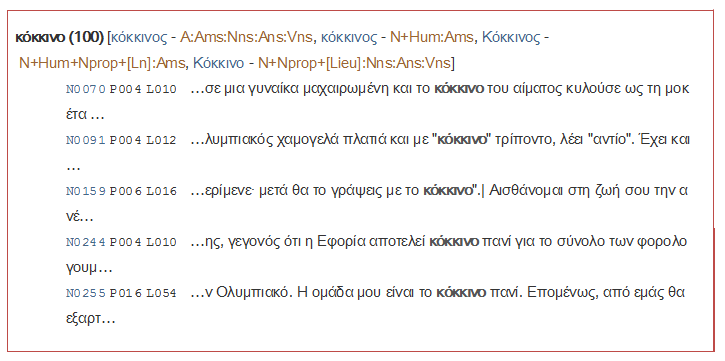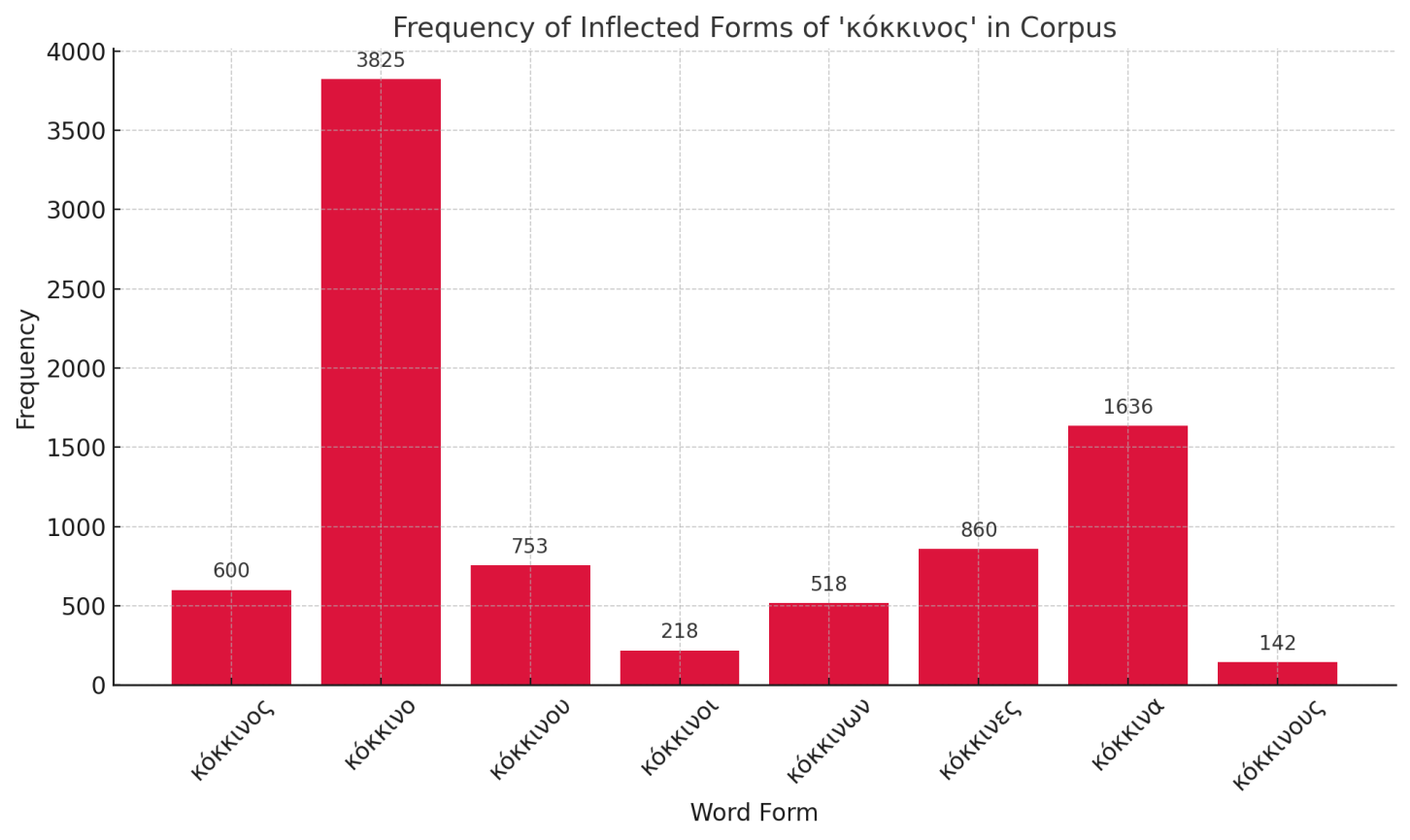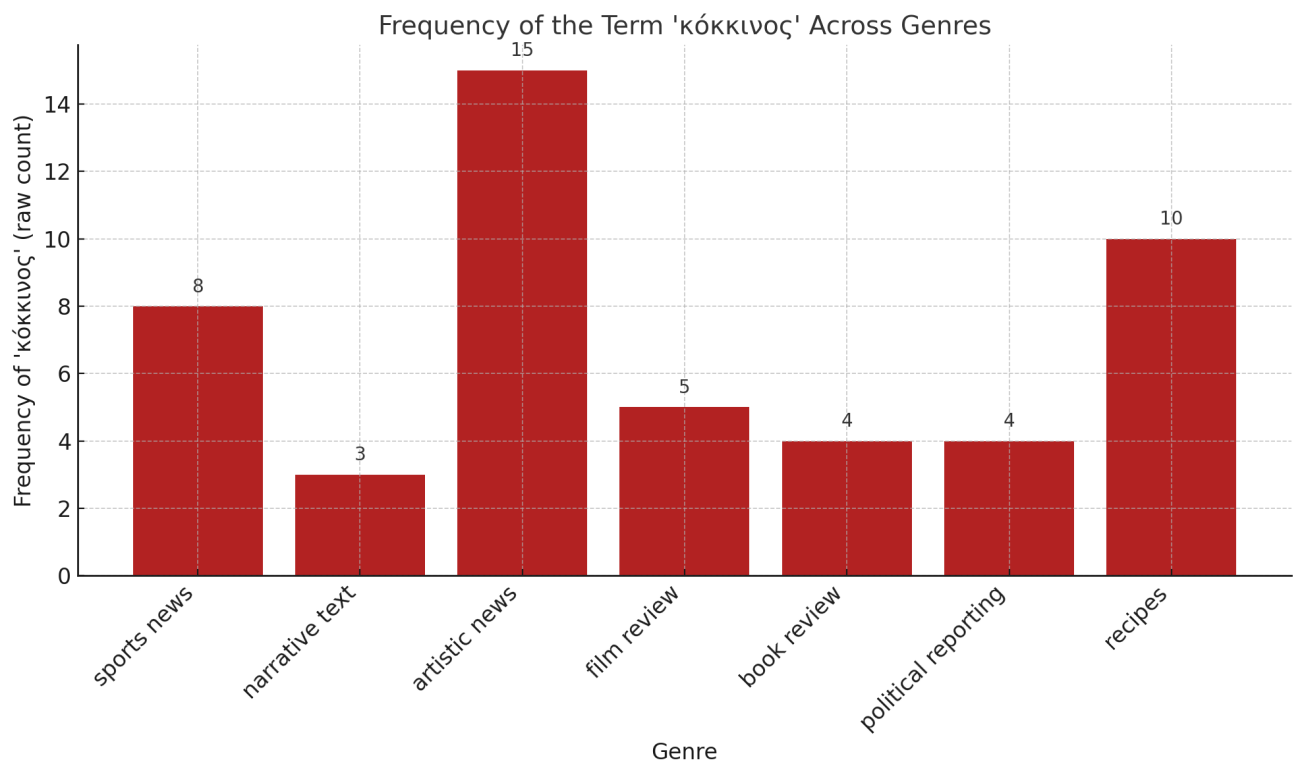Semantics in corpus linguistics: the basic colour term red in Modern Greek
Abstract
This paper argues that electronic corpora provide a rich source of data and a useful tool for semantics. More specifically, collocations, semantic preference and semantic prosody of the basic colour term kókkinos ("red") in Modern Greek are examined, using text corpora, such as Greek electronic dictionaries, SEK (Corpus of Greek texts) and Educational Thesaurus of Greek Texts. The results of the research show that such a corpus-based analysis reveals the semantic and pragmatic aspects of language, the linguistic expression of emotion concepts, through conceptual metaphor and metonymy. Collocations with this term seem to reveal a high degree of semantic opacity in the framework of conceptual metaphor. In addition, kókkinos (red) is mainly related to negative semantic prosody, denoting for instance prohibition (kókini zóni = red zone, i.e. the area where entry is prohibited), danger/emergency (kókinos sinaγermós = red alert), prostitution/immorality kókino fotáki (= red light in a tolerance house) and negative emotions such as anger (kókinos san astakós = as red as a lobster), sorrow (kókini traγoδíα = red tragedy) and shame (égine kókinos san pantzári (= He turned as red as beetroot). The originality of the research lies in the emergence of the power of context and contextual factors in linguistic analysis, using naturally occurring instances and precise corpus techniques. Regarding the study limitations, the analysis is based on a specific set of corpora (Greek electronic dictionaries, SEK, and Educational Thesaurus of Greek Texts), which, while valuable, may not represent the full diversity of language use in informal, spoken, or contemporary digital contexts (e.g., social media, forums).
1. Introduction
Corpus linguistics has emerged considerably over last decades as one of the most rapidly-developing and well-established fields of research (see Stubbs, 1996; Biber et al., 1998; Gries, 2009; Kennedy, 2014; Dunn, 2022). Large collections of machine-readable texts provide language researchers the possibility to get data easily and quickly at minimal cost, using authentic occurrences of language structure (including transcripts of spoken data) and real-life examples. Also, computerized corpora can be manipulated consistently and accurately, making the results more reliable (Sinclair, 1991, 2005; Lüdeling & Kytö, 2008; Conrad, 2010).
Through concordances and frequency lists, corpus linguists can exploit data about language, using the methods of computational linguistics for data quantitative analysis. Using methodological tools of corpora editing, researchers can derive information about collocations and semantic prosody (see Sinclair, 1991; Stubbs, 2001; McCarthy, 2006; Hunston, 2007; Bednarek, 2008; Barnbrook et al., 2013; Russnes, 2024). In the framework of cognitive linguistics, corpus linguistics has developed a large number of conceptual tools analyzing expressions of emotions (Oster, 2010, 2012; Theodoropoulou, 2012; Babanoğlu, 2015; Tsapakidou, 2015).
Basic colour terms, their collocations and semantic prosody have been studied through corpora, among others by Philip (2011), Steinvall (2006), Hemming (2012), Serakioti (2020, 2021), Hamilton (2016), Kalda & Uusküla (2019), Brosa-Rodríguez & Jiménez-López (2023), Dai & Zainal (2025), Wang & Yao (2025). Hamilton’s research uses the data source of the Historical Thesaurus of English (HT), the British National Corpus (BNC) and the Corpus of Contemporary American (COCA) to examine the meaning of basic colour terms through collocations and semantic prosody. Kalda and Uusküla (2019) study English colour metaphors used in the translation tasks, conducting a cognitive empirical study. Serakioti (2021) studies the meaning of the terms white (aspros/lefkos) and black (mavros) in Modern Greek, based on Greek Corpora and Greek dictionaries. The research results showed that the term mavros has a negative connotation, as opposed to lefkos associated with a positive connotation. Also, Serakioti (2015) examines the collocations of the colour terms galanó (light blue) in relation to galázio (dark blue) through Corpus of Greek texts.
The lack of empirical work on red represents a significant gap in the literature, especially given its cultural and symbolic importance in Greek discourse (e.g., politics, religion, emotion, and everyday language). This study aims to fill that gap by conducting a comprehensive corpus-based semantic analysis of κόκκινο in Modern Greek, drawing data from large-scale corpora that span journalistic, educational, and general language usage. By using concordance tools and collocational analysis, the study investigates both the frequency and evaluative use of the term in various genres and registers. Specifically, this study seeks to investigate the term's collocational behavior, semantic preference, and prosody – both positive and negative – across various genres. By applying principles of lexical semantics, including conceptual metaphor and metonymy, the study highlights the emotional and evaluative meanings associated with kókkinos. Ultimately, the research demonstrates how electronic corpora can uncover subtle contextual and pragmatic dimensions of meaning in naturally occurring language.
Our basic hypotheses are that κόκκινο appears more frequently in evaluative rather than purely descriptive contexts, with a tendency toward negative semantic prosody – such as associations with danger, conflict, or strong emotion. Furthermore, it is expected that its collocational patterns will vary significantly depending on genre, reflecting different cultural and communicative functions of the term.
2. Literature Review and Theoretical Framework
The semantics of colour terms has attracted considerable scholarly attention across disciplines such as linguistics, cognitive science, and corpus-based semantics. The Berlin and Kay experiment (1969) is a landmark study in linguistics and cognitive science that investigated how different languages categorize basic colour terms (see Serakioti, 2015, 2020). Through cross-linguistic analysis, the researchers identified linguistic universals in the categorization of basic colour terms. Their findings led to the formulation of a universal hierarchy of basic colour term emergence, suggesting that all languages develop colour vocabulary in a predictable sequence, starting with white and black, followed by red, and then green or yellow, blue, brown, purple, pink, orange, grey.
Later research has investigated how colour terms acquire metaphorical and evaluative meanings. For instance, Steinvall (2006) and Philip (2011) examined how colour terms function in context, revealing patterns of metaphor and collocational behavior, particularly in English. In addition, Hamilton (2016) provides a comprehensive analysis of how colour terms in English evolve from literal meanings to figurative uses through metonymy and metaphor. Her corpus-based study draws from large databases such as the Historical Thesaurus of English and explores how terms like red, blue, and green develop complex emotional and cultural connotations. She emphasizes that red commonly denotes emotional excess, danger, sin, or sexuality, often through expressions like “red alert”, “red-light district”, and “red-handed.”
Lakoff and Johnson (1980) argue that colors are frequently used metaphorically to express emotions, qualities, or states. For example, blue denotes sadness and green expresses envy (jealousy). Red is used to denote anger, i.e. in expressions like “boiling with anger” or “seeing red.” These expressions reflect how we use color concepts to frame and communicate emotional experiences. Kövecses (2002) builds on the work of Lakoff and Johnson (1980) and offers a comprehensive and systematic framework for understanding metaphor as a fundamental mechanism of human thought. Kövecses discusses how colors serve as powerful sources for metaphorical meaning. He highlights that some color metaphors are quite universal – for example, black often represents evil or death, white represents purity or innocence – while others vary widely by culture. He also analyzes color in the domain of emotions, a key area where colors are metaphorically used. For instance, red often symbolizes anger, passion or embarrassment due to embodied experiences, and blue typically stands for sadness or calmness.
From a structuralist perspective, Lévi-Strauss (1963) observes that red often functions as part of a symbolic binary (e.g., red/white, life/death) in mythology and ritual. In many cultures, this colour is associated with life force (blood, fertility), but also with violence and sacrifice. Also, Elliot et al. (2007) research in psychology show that red influences perception; red can increase attractiveness (in romantic contexts), signal dominance or aggression (especially in sports). This study investigates how exposure to the color red can impair performance in achievement contexts by evoking avoidance motivation.Furthermore, the study by Bellizzi and Hite (1992) investigates how the colors red and blue influence consumer emotions and purchasing behaviors within retail environments. The research found that red environments tend to evoke feelings of tension and negativity among consumers.
In the field of Modern Greek, Serakioti (2021) conducted a corpus-based analysis of the colour terms mavros (“black”) and lefkos (“white”), examining their collocational patterns and semantic prosody across various textual genres. Her findings revealed that mavros consistently appeared in negative evaluative contexts, such as expressions of death, sorrow, and danger, while lefkos was frequently associated with positive connotations, including purity, innocence, and peace. By employing tools such as concordance lines and frequency analysis from Greek corpora, the study provided empirical evidence of how colour terms function not only descriptively but also evaluatively, reflecting deeper cultural and emotional associations. In Modern Greek, the semantic and evaluative uses of the term κόκκινο (“red”) have not yet been studied through corpus-based methods. In Modern Greek linguistics there has been no systematic study of the color term red (κόκκινο) based on corpus analysis. Such research would fill a significant gap in the literature by providing empirical data on the semantic and evaluative uses of κόκκινο, revealing its cultural, emotional, and contextual associations in this language. This would also enable comparisons with studies on other color terms and contribute to a deeper understanding of color semantics in Modern Greek.
3. Methodology
In this study, the electronic “Dictionary of Standard Modern Greek” (Manolis Triantafyllidis)[1], SEK (Corpus of Greek texts) (Goutsos, 2003), Educational Thesaurus of Greek Texts and text corpora from journalism and Secondary School (Corpus of New Greek Texts)[2] were used in order to reveal semantic relationships that are related to the term kókkinos ("red") in Modern Greek. The total corpus used in this study comprises approximately 35 million word tokens. The Educational Thesaurus of Greek Texts consists of: 1) a General corpus, 2) textbooks corpus and 3) the corpus of texts of teachers (the teacher can insert his/her own texts). The corpus of New Greek Texts contains about 5,000,000 word tokens published in the newspapers Ta Nea (2092594 words, 4,432 texts) and Makedonia (2,608,410 words, 8,012 texts). The material is grouped based on thematic units and genres (sports news, narrative texts, film reviews, political reporting, recipes etc.). The text corpora from the field of education contain, in electronic format, textbooks (for both students and teachers) from the Lower Secondary School (gymnasion) and the Upper Secondary School (lykeion). In this way, it enables the user to find authentic examples of the use of the Greek language by searching for specific words. For instance, by entering the word “kókini”, all sentences containing this word are retrieved. In addition, corpora give the user the opportunity to search for the frequency of occurrence of words and lemmas, using statistical tools. The Corpus of Greek Texts (SEK) is a synchronic, monolingual corpus of Modern Greek that contains approximately 30 million word tokens, covering a wide range of text types and thematic categories. It includes both written and spoken texts, dating from 1,990 to 2,010 and all texts are pre-annotated with metadata specifying their mode (written or spoken) and genre, such as academic writing, news articles, opinion pieces, literary texts, interviews, and conversations. This diversity makes SEK a valuable tool for linguistic research, allowing for the analysis of word usage and phraseology across different contexts and genres.
Concordance analysis was performed using AntConc (version 4.1.0) to systematically retrieve all occurrences of the term κόκκινο and its inflected forms (e.g., κόκκινη), facilitating a comprehensive investigation of its distribution and contextual usage within the corpus. AntConc is a freeware concordance program developed by Professor Laurence Anthony. Frequency counts and collocational patterns were examined to identify semantic prosody and evaluative contexts – positive, negative, or neutral. Concordance lines allowed for close examination of the word’s co-text to analyze emotional associations and connotations related to κόκκινο in different contexts. From the retrieved concordance lines, a stratified sample was selected to ensure representation across genres and text types. Large collections of spoken or written data (corpora) seem to be ideal for the investigation of collocations through concordances in user-friendly software. It is worth noting the fact that a concordance is one core corpus-handling technique for retrieving a word or a phrase analyzing the context before and after the example (i.e. co-text). In the case of connotations, concordances demonstrate the word emotional associations, the positive or negative feelings or emotions related to that word.
This study follows a descriptive, corpus-based research design. First, instances of the color term κόκκινο and its inflected forms were extracted using keyword and lemma-based searches. Next, concordance lines were analyzed to identify co-text and collocational patterns. Finally, semantic prosody was assessed by categorizing each instance into evaluative types (positive, negative, neutral), providing insight into emotional and cultural associations. Frequency counts and collocational analyses were further processed using SPSS (version 28) to generate descriptive statistics and frequency tables of evaluative patterns.
4. Findings and Discussion
The results of the present research (see Figure 1) indicate that the term kókkinos ("red") in Modern Greek is related to the emotions of anger and rage, for example kókino paní (red flag), égine kókinos apó ton θimó tu (his face turned red with anger) / kókinos san astakós (as red as a lobster). In addition, kókinos denotes the feeling of shame (égine kókinos san pantzári/san paparúna (He turned as red as beetroot/ as a poppy). Also, the specific colour term is related to prohibition (kókinos simatoδótis = red traffic light, kókini zóni = red zone, i.e. area where entry is prohibited), warning (kókini kárta = red card – for removing a player from the match) or threatening/danger/emergency (kókini γramí = hotline – for direct or urgent communication between the governments of two countries, kókinos sinaγermós = red alert, kókinos katáloγos = red list of endangered animals). In cases, such as kókinos sinaγermós = red alert, the overall semantic prosody is negative with metaphorical extension, associated with fear, urgency, danger, and disruption. Metaphorical extensions of kókkinos highlight cultural associations, linking the color not only with physical redness but also with emotional intensity and social conventions (e.g., shame, prohibition).
(1) N0244 P004 L010 … ης, γεγονός ότι η Εφορία αποτελεί κόκκινο πανί για το σύνολο των
φορολογουμ (Corpus of New Greek Texts)
(2) N0473 P001 L001 … "Κόκκινη" γραμμή με τον εισαγγελέα Εκβιασθ… (Corpus of New Greek Texts)
(3) N0640 P015 L031 …ληνικού Κοινωνικού Φόρουμ.| Χωρίς κόκκινη ζώνη και
συρματοπλέγματα| Οι διαδ … (Corpus of New Greek Texts)
(4) Διαμάχες φατριών O κ. Καρίμ θεωρεί αμελητέο το ενδεχόμενο ενός εμφύλιου πολέμου καθώς όπως λέει «είναι η κόκκινη γραμμή που όποιος την περάσει είναι καταδικασμένος να πέσει στην μαύρη τρύπα της παλλαϊκής κατακραυγής» (Educational Thesaurus of Greek Texts)
(5) M6978 P006 L010 … απλώς τοποθέτησε περιμετρικά μια κόκκινη κορδέλα, με την οποία απαγορεύετα … (Corpus of New Greek Texts)
Also, the term kókinos refers to defamation (for example kókini láspi = red dust) and prostitution/immorality (kókino fotáki = red light in a tolerance house) in the framework of conceptual metaphor. Another collocation with kókinos is related to importance/honorable welcome (kókino xalí[3] = red carpet).
(6) Η Αίγυπτος στρώνει κόκκινο χαλί» στους επενδυτές (Educational Thesaurus of Greek Texts)
It is worth noting the fact that the term kókinos can be used to denote a Greek football team (i kókini (plural) = the team whose emblem is red). In this case we observe the linguistic phenomenon of metonymy (see Stefanowitsch, 2006); a concept is referred to by the name of something associated with that concept. This usage often carries evaluative or emotive connotations, depending on the speaker’s perspective, such as enthusiasm, rivalry, or criticism, illustrating how color terms in Modern Greek can acquire socio-cultural and affective meaning beyond their literal sense.
(7) N2303 P036 L079 … ης Λίβερπουλ και της Σέλτικ. Οι "κόκκινοι" πήραν την πρόκριση νικώντας με … (Corpus of New Greek Texts)
(8) N2710 P005 L018 … το Τσάμπιονς Λιγκ εκτός ήταν οι "κόκκινοι". Στο πρωτάθλημα, οι δύο βαθμοί … (Corpus of New Greek Texts)
More particularly, the term kókini refers to the players or fans of the Greek football team. Furthermore, the notion kókinos can express a political ideology (kókinos dímarxos = “red” mayor) and it has also been associated with blood (kókini traγοδía = red tragedy) and revolution and to socialism and communism (Kókinos Stratós = Red Army):
(9) N3334 P010 L019 … 49, αρχίζοντας με την είσοδο του Κόκκινου Στρατού στην Οδησσό και τη φυγή … (Corpus of New Greek Texts)
(10) Η τραγική φιγούρα του Σοβιετικού Γιούρι Ολέσα (1899–1960) κυριαρχεί στο νέο τεύχος του περιοδικού «Πλανόδιον» (Δεκέμβριος 2004) – μια μορφή που, όπως εξηγεί η μεταφράστρια Ευγενία Κριτσέφτσκαγια, μεγάλωσε στην Οδησσό, υπηρέτησε στον Κόκκινο Στρατό, δημοσίευσε το μοναδικό του μυθιστόρημα «Φθόνος» στα 1927 κι έγραψε θέατρο που ανέβασε ο διάσημος Μέγιερχολντ. (Educational Thesaurus of Greek Texts)
(11) Και ... ξερίζωσαν από τις καρδιές τους την κόκκινη τραγωδία (Educational Thesaurus of Greek Texts)
(12) N0390 P005 L007 … μαζί με μερικούς ανεπιθύμητους "Κόκκινους" στη Ρωσία, όπου είχε την ευκαιρ … (Corpus of New Greek Texts)
Also, the term kókinos often denotes the upper limit:
(13) Στο κόκκινο χιλιάδες επιχειρήσεις και νοικοκυριά (Educational Thesaurus of Greek Texts)
(14) Στο κόκκινο η ρύπανση (Educational Thesaurus of Greek Texts)
Figure 1. Concordance of red colour in SEK

In Figure 2, most of the collocations are conceptual metaphors and they are related to a high degree of semantic opacity.In addition, they denote negative prosody as long as they are associated to notions such as danger, prohibition, immorality and emotions, for instance anger or shame. For example, in the sentence «γεγονός ότι η Εφορία αποτελεί κόκκινο πανί για το σύνολο των φορολογουμένων» (“the fact that the Tax Office constitutes a red flag for all taxpayers”), the term is used figuratively to emphasize the public’s emotional hostility toward the tax authority. The phrase κόκκινο πανί = red flag draws on conceptual metaphor theory, specifically the metaphor “ANGER IS PROVOKED AGGRESSION”, where the red cloth symbolically incites a reaction, much like a red rag to a bull (see Lakoff and Johnson, 1980; Lakoff, 1993). This example reflects how kókkinos contributes to emotionally charged evaluative meaning in institutional and socio-political contexts, reinforcing the predominance of negative prosody in its figurative usage. Such expressions are grounded in embodied experience and culturally mediated symbolism, reinforcing how metaphor and metonymy jointly shape lexical meaning and pragmatic interpretation. These examples illustrate the rich semantic versatility of κόκκινος, underscoring its pragmatic and symbolic functions in Modern Greek discourse.
Figure 2. Concordance of red in Corpus of New Greek Texts (Newspaper “Macedonia”)

It is worth noting the fact that linguistic phenomenon of metonymy occurs in plural terms in which one entity is used to refer to another, related, entity. Our data could be compared with those of corresponding surveys which examine metaphorical extensions of red in corpora (see among others Bennett, 1988; Hamilton, 2016; Kalda A. & Uusküla, 2019). Hamilton (2016) denotes that red is related to negative associations due to its connection with blood and collocates with emotions including anger and shame. Also, MacLaury et al. (1997: 77), Kalda A. & Uusküla (2019: 692) and Vaňková (2007) support that red is related to negative emotions, such as anger. Benczes & Tóth-Czifra (2014) argue that piros in Hungarian is used more rather with positive concepts, while vörös has a negative connotation.
In Figure 3, the term κόκκινος (“red”) in Modern Greek exhibits a wide range of metaphorical extensions and idiomatic uses across various semantic domains. These collocations often reflect strong emotional or conceptual associations. In the domain of anger, expressions such as έγινε κόκκινος από τον θυμό του (“he turned red with anger”) are prototypical, while similes like κόκκινος σαν αστακός (“as red as a lobster”) also serve to intensify emotional states. Shame is expressed metaphorically through phrases like έγινε κόκκινος σαν παντζάρι/σαν παπαρούνα (“he turned red as a beetroot/poppy”), highlighting the embodied reaction of blushing. In other domains, κόκκινος is associated with sorrow (κόκκινη τραγωδία – “red tragedy”), blood (κόκκινος σαν το αίμα – “as red as blood”), prohibition (κόκκινος σηματοδότης – “red traffic light”, κόκκινη ζώνη – “red zone”), and warning (κόκκινη κάρτα – “red card”). It also occurs in expressions denoting danger or emergency, such as κόκκινη γραμμή (“hotline”), κόκκινος συναγερμός (“red alert”), and κόκκινος κατάλογος (“red list” of endangered species). Kόκκινοςκατάλογος (“red list”) refers to an official register of endangered or threatened species, highlighting those at risk of extinction. This collocation exemplifies the use of the color red to signal warning and urgency in environmental and conservation discourse. These metaphorical and idiomatic uses reflect culturally mediated symbolism, where kókkinos conveys social, political, and emotional meanings beyond its literal color reference.
Other figurative uses include defamation (κόκκινη λάσπη – “red mud”/“smear”), immorality or prostitution (κόκκινο φωτάκι – “red light”), and political ideology (κόκκινος δήμαρχος – “red mayor”, Κόκκινος Στρατός – “Red Army”). The phrase κόκκινοφωτάκι (“red light”) is commonly used as a metonymic expression referring to prostitution or red-light districts and draws on the symbolic use of red light to indicate areas where sex work is tolerated or regulated, reflecting the color red’s association with immorality and taboo in social contexts. Positive or neutral connotations also appear in collocations like κόκκινο χαλί (“red carpet”) symbolizing an honorable welcome, and στο κόκκινο (“in red”) used metaphorically to indicate intensity or reaching the upper limit, particularly in economic or performance contexts. The expression “red carpet”, which conventionally denotes an honorable welcome or special treatment, can also acquire an ironic style, depending on the context. In such cases, the metaphor takes on a critical or sarcastic function, implying that someone is receiving exaggerated or undeserved attention. The irony emerges from the discrepancy between the literal meaning of the phrase and the actual tone or pragmatic implications of the utterance. These examples illustrate how kókkinos encodes affective responses and socially shared evaluations, signaling disapproval, prestige, or caution depending on the context.
Figure 3. Figurative meanings of kókinos (“red”) in corpora

In Figure 4, the term κόκκινος ("red") appears in the corpus in various inflected forms with a total frequency of 8,552 tokens, corresponding to 0.0885‰. The most frequently occurring form is the neuter singular κόκκινο (3,825 tokens, 0.0397‰), likely due to its use in set expressions and idioms. Other high-frequency forms include the neuter plural κόκκινα (1,636 tokens, 0.0169‰) and the feminine plural κόκκινες (860 tokens, 0.0089‰), reflecting agreement patterns in nominal phrases. The term κόκκινοι (nominative plural), κόκκινων (genitive plural) and κόκκινους (accusative plural) usually denotes the members of a political party/group (878 tokens). This distribution suggests that the color term is morphologically productive and appears in a wide range of syntactic environments. The prevalence of neuter forms may also reflect their frequent use in metaphorical and idiomatic expressions. Overall, the data underscores the semantic and functional versatility of κόκκινος in Modern Greek discourse.
Figure 4. Educational Thesaurus of Greek Texts: inflected forms of the Modern Greek adjective "κόκκινος" (“red”)

Figure 5. Frequency graph of kókinos ("red") in different genres (“Ta Nea” Journal)

According to Figure 5, research results show that the word kókinos (“red”) appears in a higher percentage in genres such as artistic news and recipes, mainly in the literal meaning of the term. In contrast, its occurrence in narrative texts, book reviews, and political reporting is relatively limited. These frequencies are presented as raw counts and reflect genre-based variation in the usage of color terminology. While artistic and culinary texts tend to use κόκκινος descriptively (e.g., red paint, red peppers), political and literary texts may employ the term more metaphorically or sparingly. Comparing across genres, it is evident that while culinary and artistic texts employ kókkinos primarily descriptively, narrative and political genres exploit its metaphorical and symbolic potential, reflecting both emotional and socio-political dimensions. This variation across genres demonstrates that kókkinos conveys context-dependent meanings, ranging from negative in political and sports settings to neutral or literal in artistic and culinary domains. In the case of appearing in sports news, it includes the players of a team whose characteristic color is red, for example κόκκινοι (kókini). Also, this term appears in phrases, such as “red cards”, and it is related to negative connotation (punishment, severe warning, rejection).
In political reporting the term kókinos appears to denote a political party or its supporters (i.e. communist or socialist parties) and typically functions metonymically. Its connotative charge varies with context, ranging from solidarity and leftist identity to radicalism or dissent. This reflects the broader phenomenon of color terms acquiring symbolic and evaluative meanings beyond their literal usage. Negative semantic prosody is associated with revolution, extremism, conflict, or even danger.
In narrative texts, the term red is frequently employed with predominantly metaphorical significance, particularly in relation to the emotional states of central characters. It commonly symbolizes intense affective experiences such as anger and fear. The color red often connotes heightened emotional arousal, encompassing not only rage and aggression but also danger and alarm. Additionally, red may evoke associations with violence and blood, further reinforcing its connection to physical and psychological intensity. Thus, within narrative discourse, red functions as a powerful metaphorical device that conveys complex and visceral emotional dimensions of the protagonist. Comparing these genres, it is evident that kókkinos operates along a spectrum of meaning: in political reporting, it primarily conveys evaluative and symbolic associations tied to ideology and social positioning, whereas in narrative texts it functions as a vehicle for expressing intense emotional states and human experience. This demonstrates that the semantic prosody of kókkinos is highly context-dependent, shaped by both genre conventions and cultural knowledge.
5. Conclusions
Corpus analysis is proved to be a useful and accurate tool for linguistic research. The study results showed that the colour term kókkinos ("red") in Modern Greek is mainly associated with negative prosody, denoting anger, shame, prohibition, immorality and danger. In some examples it is related to politics (communism and socialism) and in other cases it metonymically denotes the members of a Greek team (kókkini) and it appears in the plural. Although there are expressions with a positive connotation, such as κόκκινο χαλί (“red carpet”), in a different context they may carry an ironic tone. Collocations with red seem to have a high degree of semantic opacity, due to the fact that the meaning of the phrase is not easily derived from the meaning of its members (i.e. Kókinos Stratós, kókinos sinaγermós, égine kókinos san pantzári/san paparúna). Statistically, as far as the genre is concerned, the term appears in artistic news and recipes that mainly express literal meaning, while when it appears in narrative texts it indicates a conceptual metaphor.
The corpus analysis of the colour term κόκκινος ("red") in Modern Greek demonstrates its high frequency and extensive morphological variation, with a total of 8,552 tokens identified across various inflected forms. The predominance of the neuter singular κόκκινο is indicative of its frequent appearance in noun phrases and fixed expressions. This distribution suggests that κόκκινος is a morphologically productive lexical item that participates in a wide range of syntactic constructions. The prevalence of neuter forms further points to their central role in metaphorical and idiomatic usage, underscoring the term’s pragmatic flexibility. Also, concordances are a basic corpus-handling technique displaying the word’s systematic co-occurrences in text, while co-text plays an indispensable role in the linguistic analysis providing important new insights about the word usage.
The study also showed that negative associations with kókkinos outnumber positive ones. However, it did not include quantitative analysis of the frequency of specific collocations, which is a limitation. Future research should include such quantitative data, expand corpora to include spoken and digital texts, and explore how the meaning of kókkinos may shift over time and across contexts. Ultimately, this study highlights the effectiveness of corpus-based methods in uncovering nuanced contextual and pragmatic aspects of lexical meaning, reinforcing the potential of such approaches in lexical semantic research.


















Reference lists
Babanoğlu, M. K. (2015). A corpus-based study on the use of feelings and emotions vocabulary by male and female EFL learners, International Journal of Language and Linguistics, 3 (4), 203–209. https://doi.org/10.11648/j.ijll.20150304.12(In English)
Barnbrook, G., Mason, O. and Krishnamurthy, R. (2013). Collocation: Applications and implications, Palgrave Macmillan, Houndmills, Basingstoke and New York. (In English)
Bednarek, M. (2008). Semantic preference and semantic prosody re-examined, Corpus Linguistics and Linguistic Theory, 4 (2), 119–139. (In English)
Bellizzi, J. A. and Hite, R. E. (1992). Environmental color, consumer feelings, and purchase likelihood, Psychology & Marketing, 9 (5), 347–363. https://doi.org/10.1002/mar.4220090502(In English)
Benczes, R. and Tóth-Czifra, E. (2014). The Hungarian colour terms piros and vörös: A corpus and cognitive linguistic account, Acta Linguistica Hungarica, 61 (2), 123–152. (In English)
Bennett, T. J. A. (1988). Aspects of English Colour Collocations and Idioms, Carl Winter Universitätsverlag, Heidelberg, Germany. (In English)
Berlin, B. and Kay, P. (1969). Basic Color Terms: Their Universality and Evolution, University of California Press, Berkeley, USA. (In English)
Biber, D., Conrad, S. and Reppen, R. (1998). Corpus linguistics: Investigating language structure and use, Cambridge University Press, New York, USA. (In English)
Brosa-Rodríguez, A. and Jiménez-López, M. D. (2023). Quantifying basic colors’ salience from cross-linguistic corpora, Color Research & Application, 49 (1), 34–50. https://doi.org/10.1002/col.22899 (In English)
Conrad, S. (2010). What can a corpus tell us about grammar? in McCarthy, M. J. and O’Keeffe, A. (eds.), Routledge Handbook of Corpus Linguistics, Routledge. (In English)
Dai, S. and Zainal, A. Z. (2025). An Empirical Study of Basic Color Terms in Chinese. Forum for Linguistic Studies, 7 (5), 861–872. https://doi.org/10.17507/tpls.1509.05(In English)
Dunn, J. (2022). Natural Language Processing for Corpus Linguistics, Cambridge University Press, Cambridge, UK. (In English)
Elliot, A. J., Maier, M. A., Moller, A. C., Friedman, R., and Meinhardt, J. (2007). Color and psychological functioning: The effect of red on performance attainment, Journal of Experimental Psychology: General, 136 (1), 154–168. https://doi.org/10.1037/0096-3445.136.1.154(In English)
Goutsos, D. (2003). Corpus of Greek texts: Planningand materialization, Proceedings of the 6th International Conference of Greek Linguistics, University of Crete, Greece, CD-ROM publication. (In English)
Gries, S. Th. (2009). What is corpus linguistics? Language and Linguistics Compass, 3, 1–17. https://doi.org/10.1111/j.1749-818X.2009.00149.x(In English)
Hamilton, R. L. (2016). Colour in English: from metonymy to metaphor, Ph.D. Thesis, University of Glasgow, Scotland, UK. (In English)
Hemming, J. (2012). Red, White, and Black in Symbolic Thought: The Tricolour Folk Motif, Colour Naming, and Trichromatic Vision, Folklore, 123 (3), 310–329. http://www.jstor.org/stable/41721562(In English)
Hunston, S. (2007). Semantic Prosody Revisited, International Journal of Corpus Linguistics, 12, 249–268. https://doi.org/10.1075/ijcl.12.2.09hun(In English)
Kalda, A. and Uusküla, M. (2019). The role of context in translating colour metaphors: An experiment on English into Estonian translation, Open Linguistics, 5, 690–705. (In English)
Kennedy, G. (2014). An introduction to corpus linguistics, Routledge, London, UK. (In English)
Lakoff, G. and Johnson, M. (1980). Metaphors we live by, University of Chicago Press, Chicago, USA.
Lévi-Strauss, C. (1963). Structural anthropology, translated by C. Jacobson and B. G. Schoepf, Basic Books, NY, USA. (In English)
Lakoff, G. (1993). The contemporary theory of metaphor, in Ortony, A. (Ed.), Metaphor and thought, 2nd ed., Cambridge University Press, 202–251. (In English)
Lüdeling, A. and Kytö, M. (eds.) (2008). Corpus Linguistics: An international handbook, Walter de Gruyter, Berlin, Germany. (In English)
MacLaury, R. E., Almási, J. and Kövecses, Z. (1997). Hungarian piros and vörös: color from points of view, Semiotica, 114 (1/2), 67–81. (In English)
McCarthy, M. (2006). Explorations in Corpus Linguistics, Cambridge University Press, Cambridge, UK. (In English)
Oster, U. (2010). Using corpus methodology for semantic and pragmatic analyses: What can corpora tell us about the linguistic expression of emotions? Cognitive Linguistics, 21 (4), 727–763.
Oster, U. (2012). “Angst” and “fear” in contrast: A corpus-based analysis of emotion concepts, in Brdar, M., Raffaelli, I. and Fuchs, M. (eds.), Cognitive linguistics between universality and variation, Cambridge Scholars Publishing, Newcastle, UK, 327–354. (In English)
Philip, G. (2011). Colouring Meaning. Collocation and connotation in figurative language, John Benjamins, Amsterdam/Philadelphia, Netherlands. (In English)
Russnes, M. (2024). Semantic prosody, semantic transfer and semantic change, ICAME Journal, 48(1), 67–88. (In English)
Serakioti, D. (2020). Quantifying Semantics Using Statistical Tools: An Empirical Research in Colour Compounds in Modern Greek, European Scientific Journal, 16 (23), 185–205. (In English)
Serakioti, D. (2021). Semantic analysis of the color terms áspros/lefkós (white) and mávros (black) in Modern Greek, Proc.13th International Conference on Greek Linguistics, University of Patras, Patras, Greece. (In Greek)
Serakioti, D. and Stefaneas, P. (2022). Ambiguity in Argumentation: The Impact of Contextual Factors on Semantic Interpretation. Studia Humana, 11 (3–4), 18–24. https://doi.org/10.2478/sh-2022-0012 (In English)
Sinclair, J. (2005). Corpus and Text. Basic Principles, in Wynne, V (ed.), Developing Linguistic Corpora: A Guide to Good Practice, Oxbow Books, Oxford, UK, 1–16. http://hdl.handle.net/20.500.14106/dlc(In English)
Sinclair, J. M. (1991). Corpus, concordance and collocation, Oxford University Press, Oxford, UK. (In English)
Stefanowitsch, A. (2006). Corpus-based approaches to metaphor and metonymy, in Stefanowitsch, A. and Gries, S. T. (eds.), Corpus-based approaches to metaphor and metonymy, Mouton de Gruyter, Berlin & New York, Germany & USA, 1–16. (In English)
Steinvall, A. (2006). Basic Colour Terms and Type Modification: Meaning in relation to function, salience and correlating attributes, Progress in Colour Studies: Volume I. Language and Culture, 57–71. (In English)
Stubbs, M. (1996). Text and Corpus Analysis, Computer-assisted Studies of Language and Culture, Blackwell, Oxford, UK. (In English)
Stubbs, M. (2001). Words and Phrases: Corpus Studies of Lexical Semantics, Blackwell, Oxford, UK. (In English)
Theodoropoulou, M. (2012). The emotion seeks to be expressed: Thoughts from a linguist’s point of view, in Chaniotis, A. (ed.), Unveiling emotions: Sources and methods for the study of emotions in the Greek world, Steiner, Stuttgart, Germany, 433–468. (In English)
Tsapakidou, K. (2015). Emotion and feeling in emotion talk, M.A. Thesis, Department of Linguistics, School of Philology, Aristotle University of Thessaloniki, Greece. (In English)
Vaňková, I. (2007). To have color and to have no color. The coloring of the face in the Czech linguistic picture of the world, in MacLaury, R. E., Paramei, G. V. and Dedrick, D. (eds.), Anthropology of color: Interdisciplinary multilevel modeling, John Benjamins, Amsterdam/Philadelphia, Netherlands, 441–456. (In English)
Wang, S. and Yao, Y. (2025). The Semantic Evolution and Cultural Cognition of the English Basic Color Term ‘Green’ — A Diachronic Analysis Based on Cognitive Anthropology, Nature Anthropology, 3 (3), 10013-10013.